 Bitter melon is another thing that you either love or hate. Among my friends and relatives who have tried bitter melon, 42 percent(*) find it too bitter to try a second time. My mom is a special case. She used to shun it, then little me got a bad fever and had to eat it to help lowering my temperature (bitter melon has medicinal effects), mom was so worried that I wouldn’t eat it (like every toddler, I didn’t like food), but I chowed it down at first try, mom got curious, tried and started liking it too. That’s the story she told me, but I think she started liking it because she started making it, and everything she makes tastes great. Even in the Bay Area, bitter melon is somewhat rare and expensive. The only restaurant I know of that has bitter melon is China Village on Solano, and a plate costs 10.95 with 70% egg and 30% bitter melon. Sushi California used to have it as an Okinawan specialty but had to cut it due to low demand. 🙁 […]
Continue reading Recipe: Stir-fried bitter melon and egg (kho qua xao trung)
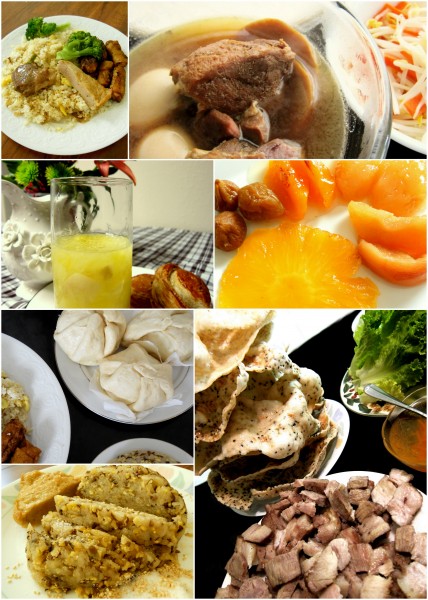 Been one measly week since I got back to the West Coast, and my stomach is already shifting in discomfort with the regular irregular dining pattern of a student, or perhaps of just someone living alone. At home, on weekdays, we have dinner at 5 while watching TV. For lunch there are banh bao that Mom made, each as big as a small fist with a pork ball and a half an egg inside, refrigerated. I just need to microwave it for 1 minute. On Saturday or Sunday, I’m in charge of choosing a restaurant for lunch, preferably somewhere near Bellaire, where Mom buys a couple of banh gio, which I can also have for lunch during the week, and a pound of cha lua. For dinner, usually something small, since we are already too full from lunch. This time home, my favorite dinner has been toasted french bread with pâté and cha lua. (Mom tucked 2 cans of pâté into my backpack before the flight. Airport security didn’t like the look of them on screen so they had to do a bag check. […]
Continue reading Went home to eat
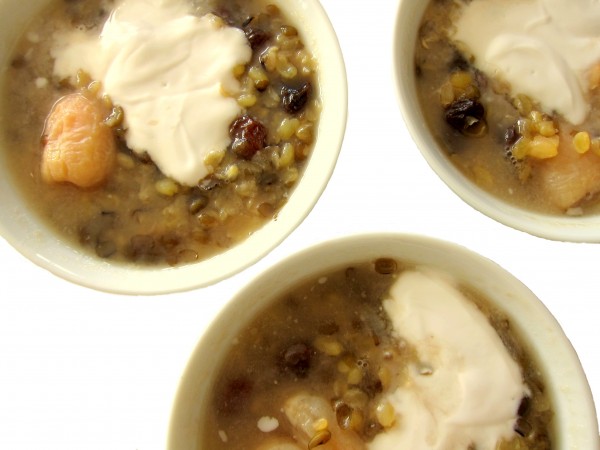 This dessert requires no skill in the making, but it ranks way up in the chè hierarchy, topping taro che and my own banana tapioca pudding. Beside the fact that Little Mom invented it, I always like things with lychee. 😉 Because everyone’s sweet tooth differs, it doesn’t make sense to have a fixed recipe for this simple dessert. One package of halved mung bean (with the green skin on), 1 can of whole lychee, 1 can of coconut milk, raisins, sugar and water are all there is to the pot. The mung bean need to be soaked in water overnight to soften and cook faster. The coconut milk and the syrup from the lychee can are mixed with water to cook the bean. More or less water depends on how thick you like your chè; the more liquidy chè served cold, which I prefer, is suitable as a palate cleanser after a big meal, and the thicker version is best as a midday snack. When the mixture boils and the bean becomes soft enough to dissolve in your mouth, add raisins and sugar to taste. Wait […]
Continue reading Lychee and mung bean che (Chè đậu xanh trái vải)
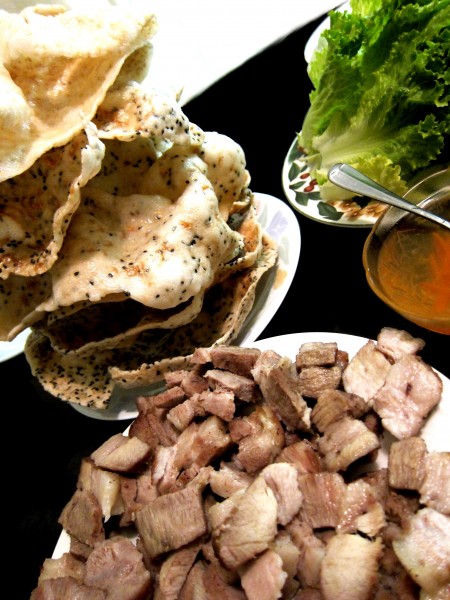 It’s the 29th of the 12th month in the lunar calendar. The last day of the Year of the Cat. The last day before Tet officially starts. But the preparation for Tet is also Tet. Having a good time is also Tet. Being home is also Tet. 🙂 One of the best parts of being home is not just getting to eat a lot. It’s getting to eat a lot of food that I would never have known otherwise. This time, Little Mom introduced me to the Central Vietnamese fun of a rice cracker roll. When I first heard the name, I thought I heard it wrong: how can you make a roll out of a stiff, crunchy, airy rice cracker (which we call a bánh tráng nướng in the South, or bánh đa in the North)? Simple. You dip it into water. Just like you would with the normal dry rice papers to make gỏi cuốn or chả giò. Except in this case, you get an extra thick roll with some crunch and air in the bite, and the nuttiness of thousands of sesame seeds ingrained in every bánh đa. The filling […]
Continue reading Central Vietnamese rice cracker roll (bánh đa cuốn thịt)
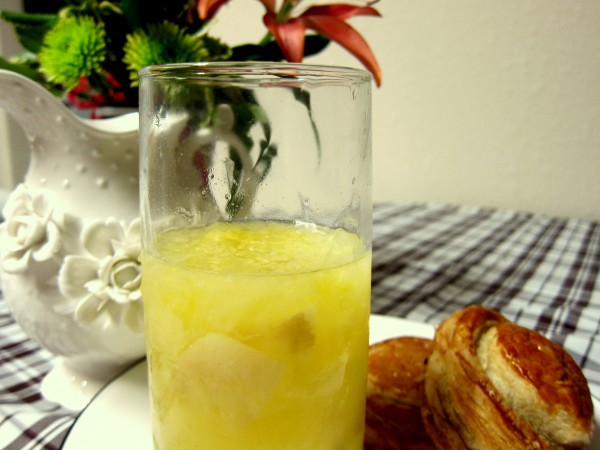 The triple punch from Little Mom: orange, lemon, and salted lime. Like instant ramen and popsicles, it all started from the leftovers: half a glass of a-little-too-salty salted lime drink, half a too-sour-to-eat orange, another half glass of normal lemonade (although Little Mom’s lemonade is not quite like any other lemonade, in a good way), and an ounce of reasoning. There was no sense in keeping them separately. The combined power shines a sweet yellow of tourmaline, smells like an orchard near the harvesting season, and tastes good enough to get me all poetically cheesy. Below is Little Mom’s recipe for the salted lime. As for the recipe of this “tricitronnade”, I would imagine that the orange doesn’t have to be sour. 😉 Continue reading Tricitronnade – Three-in-one Lemonade
 If you had to choose, what is the most Vietnamese dish? If you are a Vietnamese expat, what would make your mouth water the most just thinking about? What is the food, the smell, the taste that when you see or hear some stranger is savoring, you’d immediately think, “hey, he must be my fellow countryman”? One of my friends lives in Freiburg, Germany. There is one Vietnamese restaurant 1 km away from the University, der Reis-Garten, and it is the only Vietnamese restaurant in a 40-km radius (the next one is across the border: Le Bol d’Or in Wintzenheim, France). For over 6 years living away from home, he survived on pasta and tomato sauce, students don’t have time. One day, external circumstances have finally driven him to decide that he no longer needs to suppress his cravings out of consideration towards his Germanic housemates. He bought a bottle of fish sauce. The next day he made thịt kho. That makes it official: he’s Vietnamese, and he hasn’t forgotten it. “Success?” “Did you add coconut juice?” “Do you have eggs in the pot?” “Do you have chả lụa […]
Continue reading Year in, year out, savoring the savoriest of pork
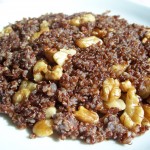 It has the texture of corn germs (the flat yellow seed inside each corn kernel). With the tiny mahogany peel cracked open just a little, each quinoa seed spills out its soft white flesh, the combination gets amusing. It’s like broken rice but more vigorous and inhomogeneous, or sesame but more fleshy. It goes well with walnuts either mixed in at the beginning or added at the end. If you think hard about it, it even tastes like clariid catfish eggs. Several ideas spring up: quinoa chè? quinoa xôi (sticky rice with quinoa or quinoa with mung bean)? quinoa bread, quinoa pie? Have you cooked with quinoa before? What is your experience with it? Continue reading Little red riding seeds
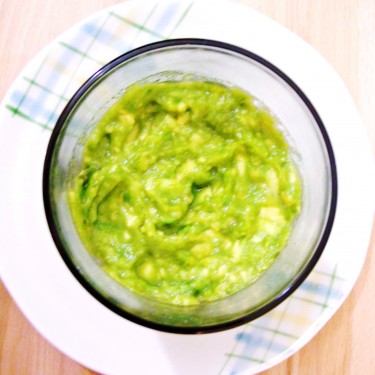 Who do you think is more confused about his identity, the penguin or the avocado? The penguin is the prime example of a bird that can’t fly. The avocado is the most commonly known fruit that doesn’t taste like a fruit. It lacks the citric hint of berries and oranges, the crunch of apples, the pulpiness of peaches and plums. If I were an avocado I’d ask myself several times a day, why did mom and dad make me taste like butter and different from every other fruitie at the market? A good avocado mom tree, like all good moms, would say “Av, being different is a good thing!”. – But I don’t get to hang out with the other fruits, they say I’m fat. – The other fruits can’t make Ice Cream by themselves. They’re only side flavors. You can become Ice Cream all by yourself. – If Sugar helps me. – Sugar is nice, but you also have what it takes to be a good Ice Cream. And think about what you can do for others if you learn from Butter and Cheese, you have their smoothness too. If I were an avocado, […]
Continue reading The avocado’s sweet side
 3 cups of rice, 3/4 lbs cha lua, 1.25 cucumbers, 3 avocados. Made 10 fat rolls of kimbap. We used long grained rice because we didn’t want to bother buying short grains, giving the rice a little more water than what the cooker says, and it’s sticky, but gotta roll quickly or the rice would dry out, perhaps in hindsight short grain would do the job better? Seasoning the rice calls for sugar, salt, and vinegar, but ubercmuc detests the taste of vinegar, hence water substituted. Inadvertently, my rolls deviate from Maangchi’s by a great distance. Cha lua (also labelled giò lụa) was bought at a local Vietnamese shop in Little Saigon, hot and fresh from the steamer. Don’t buy those frozen things at the Asian supermarkets, who knows how long they’ve been there. I cut up the cha lua and boiled the slices to lessen the nuoc-mam flavor (which is only a wisp to begin with). It is a much better meaty core than crab stick. We weren’t sure if we got nori or kim, the sheets are green instead of black, salty, and have a noticable taste […]
Continue reading Cha lua kimbap
 1. This is real, homemade chả giò – fried rolls of ground pork, shrimp, carrots, and jicama wrapped in rice paper (not the stuff made with thick yellow sheets called “egg roll” in restaurants). These won’t make the cut for a roll beauty contest, the grease will probably fatten your blood clots, but to me they’re worth a few years of life. I like them freshly fried and crunchy, I like them microwaved and chewy, and I like them cold, too. My mom makes supersized cha gio, five little piglets and you’ll lie flat on your back rubbing your tummy. 2. Fried wonton: here’s where the yellow flour sheet comes on stage to be a wrapper. Same stuffing as the cha gio, different shape, different texture. They make great bite-sized snack, both by themselves and wrapped in lettuce. Yay for more fat. But remember, Asians are skinny, so what to be afraid?
|
|
Blogs we read
|










